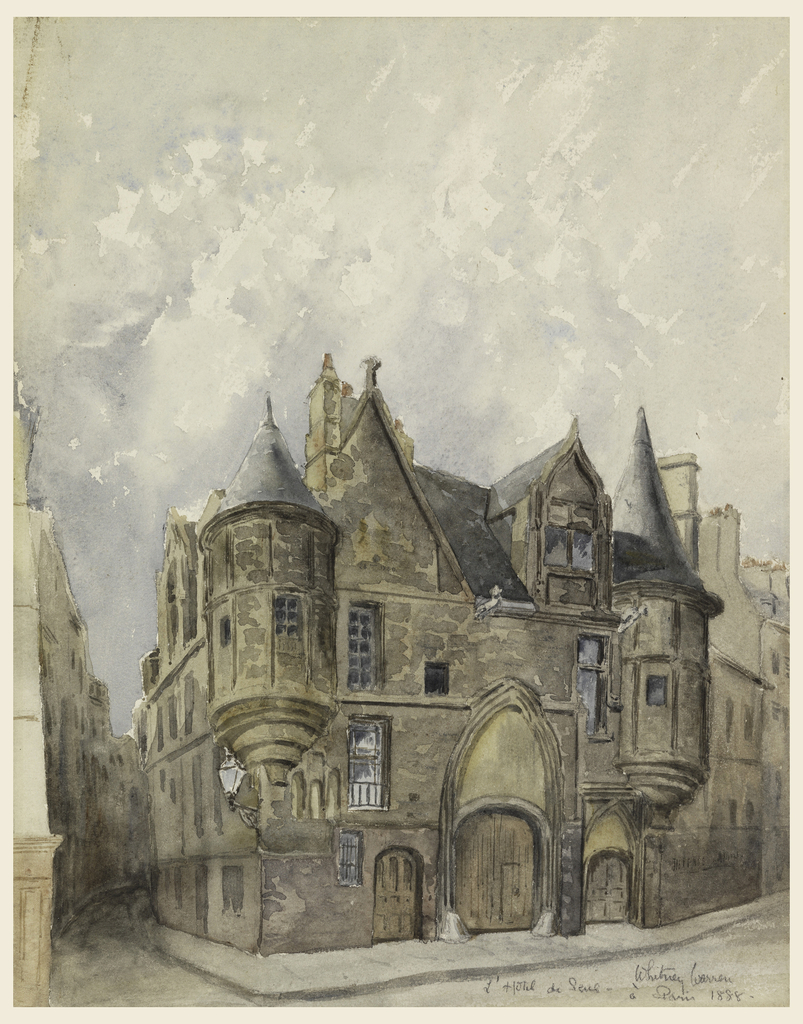There is one other image of this object. This image is in the public domain (free of copyright restrictions), and as such we offer a high-resolution image of it. See our image rights statement.
See more objects with the color silver grey dimgrey rosybrown darkslategrey or see all the colors for this object.
Object Timeline
|
1947 |
|
|
2012 |
|
|
2015 |
|
|
2025 |
|
Drawing, Hotel de Sens, Paris, 1888
This is a Drawing. It was created by Whitney Warren Jr.. It is dated 1888 and we acquired it in 1947. Its medium is brush and watercolor on paper. It is a part of the Drawings, Prints, and Graphic Design department.
Before architecture firm Warren & Wetmore erected Gilded Age estate houses on Long Island, Newport country clubs, Park Avenue apartment blocks and the Beaux-Arts style Grand Central Station[1], Whitney Warren (1864-1943) spent ten formative years in Paris – from 1884 to 1894. Trained by historicists Honoré Daumet and Charles Girault at L’École des Beaux-Arts,[2] the American architect put his new skills to the test during summer sojourns throughout Europe. With sketchbooks readily at hand, the young practitioner produced a prolific set of study drawings – 230 of which are in Cooper Hewitt’s collection. Documenting churches in the Azores or Dutch townhouses, these watercolor and graphite sketches demonstrated a rigorous attention to architectural elements, including ornamental details and even dimensions.[3]
It’s no wonder that, like many of his contemporaries, Warren cultivated an appreciation for the gothic vocabulary of French Renaissance during the course of his time in France.[4] A great example of his affinity for this style can been seen in this watercolor drawing of Hotel de Sens. Built in the heart of Paris’ Marais district during the late 15th-century for the archbishop of Sens, this ecclesiastic residence features steep roofs, turrets, dormer windows and door-frames with “delicately mounted ornaments,” all stylistic embellishments consistent with the French Renaissance style.[5] Along with other examples comprised in his sketchbooks, this drawing would later act as reference material for many of the United States-based projects Whitney and partner Wetmore would complete throughout the early twentieth-century. Employing historical French features, the firm helped establish the Beaux-Arts style in America. Such a drawing would have been crucial in Warren’s meticulous reconstruction of the World War I-damaged library at the University of Leuven, Belgium – completed in 1928. These sketchbooks maintained a link to the architect’s tenure in France, an exposure and education that shaped much of his career.
[1] Warren and Wetmore architectural drawings and photographs, 1889-1938. Avery Architectural and Fine Arts Library. Drawings and Archives Collection. Columbia University. Acc. October 21, 2015. http://clio.columbia.edu/catalog/2350596.
[2] “Warren Whitney.” The Encyclopedia Americana. 1957 ed. New York: Americana Corporation, 1957.
[3] Katie Shelly, “Collection Spotlight: Whitney Warren | Cooper Hewitt, Smithsonian Design Museum, ” Cooper Hewitt Smithsonian Design Museum, July 28, 2011, Acc. October 21, 2015. http://www.cooperhewitt.org/2011/07/28/collection-spotlight-whitney-warren/.
[4] Ian Wardropper, “Flowering of the French Renaissance,” Metropolitan Museum of Art Buletin 62 (Summer 2004): 9.
[5] M. Troche, “Notice Historique Sur L’Hotel De Sens Ancienne Résidence a Paris Des Archevêques De Sens,” Revue Archéologique 4e Année, no. 1 (March 1847): 148. Acc. October 21, 2015. http://www.jstor.org/stable/41745622.
This object was featured in our Object of the Week series in a post titled A French Renaissance Love Affair.
This object was donated by Mrs. William Greenough.
Its dimensions are
40.7 x 32 cm (16 in. x 12 5/8 in.)
It is signed
Signed in graphite, lower right: Whitney Warren
It is inscribed
Inscribed in graphite, lower right: L'Hotel de Sens - à Paris 1888-
Cite this object as
Drawing, Hotel de Sens, Paris, 1888; Whitney Warren Jr. (American, 1864–1943); France; brush and watercolor on paper; 40.7 x 32 cm (16 in. x 12 5/8 in.); 1947-17-4
